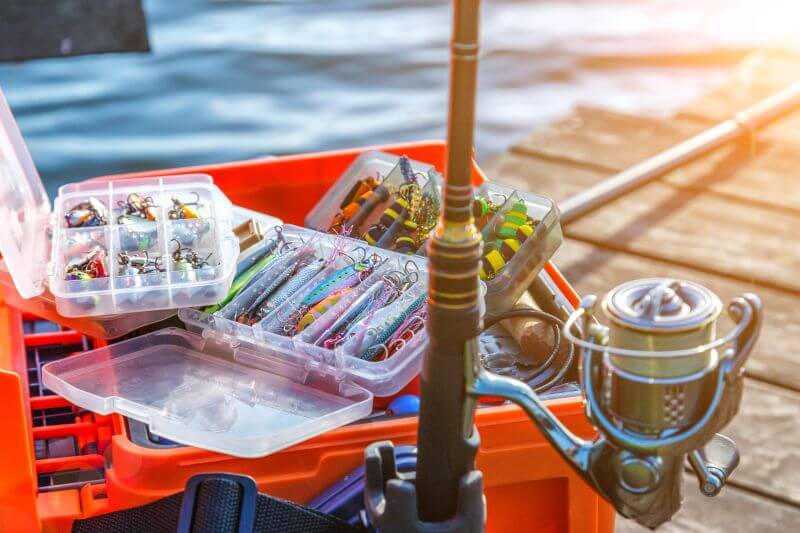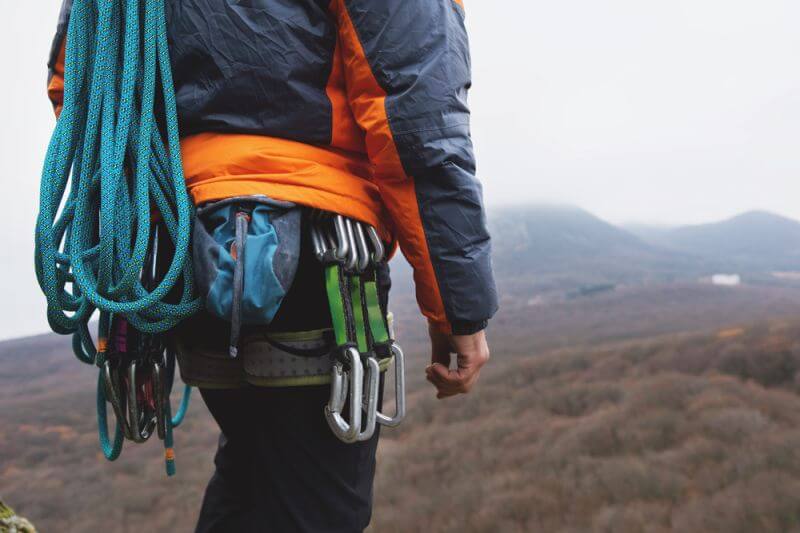One of the big challenges of bugging out is having enough food. Somehow, we’ve all gotten the idea that a bug out bag should have three days’ worth of food, and only three days’ worth. That’s okay if you can get to your survival retreat or at least to one of your food caches in that amount of time… but what if you can’t? What are you going to eat, when those three days’ worth of food run out?
The obvious answer is to harvest food from nature. What you harvest will depend on what’s available, along with your own ability at hunting, fishing, trapping or gathering. If you aren’t good at edible plant recognition, that leaves hunting, fishing, and trapping. Doing any of those, while traveling, means that your food gathering will need to be very efficient. You won’t be able to spend half the day hunting or fishing. For the most part, fishing is the easiest way to harvest any sort of food from nature.
Fortunately, a survival fishing kit is not only a standard part of a bug out bag, but also most survival kits. At least, what people refer to as a survival fishing kit is. Personally, I’ve never been convinced that what most people put in a survival fishing kit is sufficient to the task. I suppose if you’re only going to go fishing once or twice that will work; but not if you’re going to be living off the land to any extent.
I don’t know about you, but I can’t go fishing without losing a lot of line, hooks, bobbers, lures, weights and other small gear. With that in mind, how many fish am I going to catch with only two hooks and one bobber? Worse than that, what am I going to eat after those hooks are gone? Anything else is going to require more time and more work.
This is why I’ve never stuck to the standard survival fishing kit, unless we’re talking about a survival kit that is the size of a paperback book, or smaller. Even then, I’ll up that 2 fish hooks to a dozen and add a couple of extra bobbers. But even that is limited; only intended to provide me with food for a few days. What I carry in my bug out bag or any other major survival kit is considerably more.
Let’s Start with the Basics
Starting with that basic survival fishing kit as our base, what needs to happen to it to make it useable for more than a day or two? It needs more; more hooks, more line, more bobbers and more weights. Other than the weights, all of that is light, so adding more really doesn’t affect our overall pack weight all that much. We’ll talk about what to do about the weight in a minute.
You can buy a box of 100 fish hooks, or more, for $10. That will usually come in a plastic box, with various compartments, each holding a different size. Those sizes might be important, as you might even up fishing in more than one place, where you’re fishing for different sized fish. Oh, and that box of fish hooks probably isn’t going to be much bigger than a pocket-sized box of wood matches.
Fishing line is another thing we shouldn’t skimp on, considering its low cost and light weight. A 200-yard spool of fishing line can be found for as little as $3. The spool is hollow, making it a great place to stash other fishing supplies, keeping them all together. Buy a heavy-enough weight line, that you’re not going to have to worry about it breaking on you. This isn’t sport fishing, where we’re pretending to give the fish an even chance. This is survival of the fittest and no fish should be more fit at survival than you are.
Bobbers are another low-cost item, once again making me wonder why we only put one in a survival fishing kit. Why not buy a bag of 50 for $10. Okay, maybe 50 bobbers is going to take up a lot of room; but you could cut that in half and have almost no weight to consider. I’d go for the Styrofoam ones, rather than the plastic ones, as the plastic ones break easier.
Weights are Trickier
While it is possible to buy small assortments of lead weights, just like it is possible to buy assortments of hooks and bobbers, there’s one big difference. That is weights, by their very nature, are heavy. A small box of 25 assorted weights is roughly ½ pound. When you’re trying to keep your pack weight down, a half a pound makes a difference.
This took a bit of experimentation; but I finally came up with an acceptable, low-weight solution. It’s not as good as lead weights; but it is a while lot lighter… at least as far as your pack is concerned.
The solution I came up with is to use wire loom. You’ve probably seen this, even if you don’t know that’s what it is called. Wire look is the braided covering that they put over wire harnesses, in the engine compartment of your car. There are two types of loom used, the braided wire loom and the split one. The split one is molded, convoluted plastic, split down its length. That’s not the kind you want. You want the braided one, which looks like a plastic version of the “Chinese finger cuffs” we all played with as children. I prefer ½” diameter braided loom, as it is an easy size to work with.
There are a couple of characteristics of this braided loom which make it perfect to use as a weight holder. First, when you push on the ends, it gets wider. So, that ½” loom can easily be ¾” wide. Secondly, it can be heat sealed, meaning that you can cut off a piece and heat seal the end with a butane lighter. You can also heat seal it with a hot piece of metal, like a knife.
To use this braided wire loom for a fishing weight, cut off a piece a couple of inches long and seal one end closed. Then fill the loom with pebbles. Once filled, the other end can be heat sealed as well, making an effective fishing weight, even though it is larger than a lead weight. Run your fishing line through the holes in the loom to string it onto your fishing rig.
What About a Fishing Rod?
The fishing rod is something I would avoid carrying in a survival fishing kit. I bought an ultra-compact, collapsible fishing rod and reel (the rod extends to 40” long), with the idea of putting it in my survival fishing kit. While it was compact and light enough to include in the kit, it was time, not weight that made me decide to take it back out. Using a fishing rod to catch fish takes time; and while it might be effective, nobody really has time to sit by the side of a pond or stream, catching fish, when they are trying to survive.
Yet, there are still times when it is necessary to dangle bait in the water, waiting for fish to come and eat it. That’s not the only way to fish; but it is one of the more common ones; and one that we really shouldn’t ignore.
There is one slightly irregular solution to this problem, which seems to have been made just for preppers. It’s called the “Yo-yo automatic fishing reel.” These come packaged singly or several together. I carry a package of 4 in my bug out bag, which weighs just about ½ pound. By carrying several, I can bait them all and put them in the same stream or pond, increasing my chances of catching something. Should a fish bite at my bait, a spring in the reel pulls in the line rapidly, hopefully hooking the fish.
For these reels to work, they need to be anchored to something, like an overhanging tree or a bush that’s growing alongside the water. It is also useful to make a leader to attach to the existing line, as the line that comes in the reel is a bit too visible. But when used properly, they are a great fishing aid, which doesn’t require any effort, past setting them up.
If I Only Had a Net
Nets can be extremely useful while fishing; not only to bring your catch ashore, but also in catching the fish themselves. But fishing nets of whatever sort are a bit bulky to be carrying in a bug out bag. The solution is to just carry the netting material, without bothering to carry any sort of frame for it.
I carry a couple of yards of lightweight netting in my bug out bag. The biggest problem I had, was finding netting that had small enough holes in it, that fish wouldn’t be able to swim through it. The two yards I have is enough to use in multiple ways.
One way I can use my netting is in setting up traps. The standard method of driving sticks into a stream body, forming a trap for fish to swim into is effective; but can be time consuming; especially when you consider how many stakes you actually need, so that the fish can’t swim between them. My solution is to use stakes about every six inches apart and let the stakes support my netting, which fills the space between them. I can cut the netting into strips a foot to 18” wide, allowing it to cover more space.
The other way I can use my netting is to make a frame for it out of a thin forked branch. Attaching the netting to the two arms of the branch with wire ties makes an excellent net for scooping fish out of the water, whether caught by my automatic fishing reels or just being fish that I spotted swimming through the water.
Don’t Forget the Trident
There’s a reason why Poseidon always carried a trident as his weapon and symbol of power. That’s because the trident is an excellent way to spear fish, with the three prongs increasing your chances of a hit, rather than a miss. I’ve seen a number of videos, where survival instructors demonstrate making a trident out of a tree branch or sapling. From my experience, it takes a little practice to be able to make one right and not have the prongs fall apart when you try to use it. But with that practice, they are very effective.
As an alternative, making things easier, I have found that you can buy trident heads for use in spear fishing. There’s a lightweight one, which looks like nothing more than three barbed wires, attached to a cap that goes on the end of a pole. You can also buy one that is a stainless steel “survival card” about the size of a credit card, which was designed specifically to go into a survival kit. While not as perfectly formed for spear fishing as the other, it is lighter and more compact, fitting easily into a survival fishing kit.










Alan | July 19, 2024
|
A “bank line” is a rope, string, fishing line, paradors, etc. that runs from tree or bush to bush, a few feet off the ground, parallel with the shoreline and separate fishing lines are attached every few feet. FYI
Ronald Levine | July 19, 2024
|
Consider the categories of what is carried with “outside the box thinking” with the breakdown being consumables and non-consumables. Explained well in this article is a pack can’t carry enough consumables like food, water, cooking fuel for extended support of that nature. Even packing for a week that way is likely too heavy.
In sharp contrast, my pack contains minimal or even nearly zero consumables, so instead of being packed for a couple or a few days, it’s going to keep on providing by facilitating me getting food and purifying water rather than carrying a necessarily limited amount that will run out.
I particularly agree with and applaud this article on prioritization of fishing capability.
[email protected]